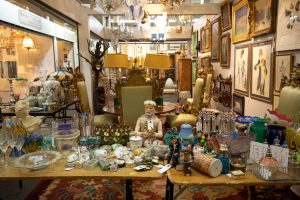Negozio Antiquariato Roma are often a treat for those looking to find unique pieces of home decor, furniture, or heirloom jewelry. It is important to make a list and take inventory before going antique shopping near you to be sure to get the most out of your trip.

It is also important to know the difference between an antique and vintage, especially when it comes to furniture.
When you walk into a large antique mall or a packed-to-the-brim antique store, it can be easy to get overwhelmed by the vast selection of items on display. To help you navigate through the crowded booths and find treasures that will speak to your home, you should prepare yourself ahead of time. The best way to do this is to have a clear idea of what you’re looking for, which may be something as simple as a statement chair or as complex as an entire collection of china.
If you’re a beginner, it’s also a good idea to visit the booths early in the day or right after they refresh their inventory, when prices are typically lower. You can also do a little research beforehand, either online or on websites that specialize in antique valuation, to understand what fair prices are for specific categories like glass collectibles or furniture pieces.
Antiques are not only beautiful additions to a home, but they can also be a great investment. If you take care of your purchases, they’ll often hold their value or even increase in value over time. Antiques are also a great alternative to new furniture, which can be costly and less environmentally friendly.
Plus, if you’re shopping for something more unique, antiques can give your space a one-of-a-kind feel that new pieces simply cannot replicate. And don’t be afraid to embrace the scuffs and scrapes, as these are often signs of long-lasting use and the proud battle scars of your new-to-you treasure. Plus, when you buy vintage and antique furniture or other decorative items, you’re not contributing to the waste from mass production that often ends up in landfills.
Know What You’re Looking For
When it comes to antique shopping, there are many options for finding unique treasures that can add character to a home or complete a collection. From flea markets and second-hand stores to large antique malls, there are lots of choices for antique seekers. However, one of the best places for the most unique and high-quality finds is at an antiques store near you. These spaces feature a huge selection of vendors with everything from antique furniture to heirloom jewelry and collectible items.
Before heading to the antiques store, it is a good idea to have a clear idea of what you are looking for. This will help keep you from getting distracted or wasting time. A few things to consider include what colors you like, the decor style you want (such as modern, vintage, or farmhouse), and any specific item sizes you need for furniture pieces. It is also a good idea to bring your own measuring tape to the antiques store with you so that you can see how well an item will fit in your space before buying it.
Having a clear vision will also help you avoid overpaying. If you are unsure of the value of an item, it is always good to consult online marketplaces or antique valuation sites for guidance. Additionally, if you are buying any textiles from an antique store, make sure to carefully inspect every fold and stitching. A small amount of human error in a vintage textile is a sign of authenticity, while an overly clean textile may be newer.
Another great way to shop at an antiques store is by focusing on one particular theme. For example, you can choose to focus on 1950s kitchenware or art deco figurines and build your collection over time. This is a fun and creative way to use antiques in your home, as it can create a cohesive design that tells a story.
Know the Difference Between Antique and Vintage
When shopping for antique furniture, it’s important to understand the difference between vintage and antique. Antiques are pieces of furniture that have been around for a long time, primarily because they were made before factory production became common. This makes them one-of-a-kind and often deeply personal to their owners, as well as valuable to others.
The general consensus amongst antique collectors is that items are considered antique if they are over 100 years old. This is a good benchmark to keep in mind when searching for antiques, as it indicates that an item was created at a different time and may have a unique value for historical or decorative purposes.
Antiques are also prized for their craftsmanship, as many were created prior to factories becoming widespread. This means that their designs and materials are often more refined than newer products, adding to their value. For example, antique furniture is often crafted with a variety of woods, including mahogany, oak, pine, and even Chinese elm, which adds to its distinctive look and feel.
While it’s easy to get swept up in the excitement of antique shopping, it’s important to remember what you’re looking for and why. To help you stay focused, it can be helpful to create a list before heading out and to research the types of antiques you’re most interested in. If you’re not sure what type of antique you’re searching for, talk to family members and friends about the pieces they own.
Additionally, watch shows like Pawn Stars and American Pickers for a glimpse into how antiques are collected and sold at auction or at the flea market. These shows are part adventure, part history lesson and, who knows, maybe you’ll get inspired to start your own collection.
Know the Store’s Return Policy
When antique shopping, it’s important to know the store’s return policy in case that one-of-a-kind antique chaise lounge you thought would look perfect in your home turns out not to. Most antique mall vendors are constantly updating their booths, so that item may not be there next time you visit. Keeping this in mind will help you make the right decision when it comes to that special piece of furniture or that stunning antique clock.
Also, remember that antiques and vintage items are not made to be pristine. They are often well-made and sturdy, with scuffs and scrapes that show their history of use. They may have an old smell, but a good cleaning can usually get rid of that, and airing them out periodically will keep them smelling fresh and looking great. Buying antiques is also a sustainable way to decorate, as you’ll be keeping perfectly usable items out of landfills and reducing your carbon footprint.
At Kudzu Antiques, we take a lot of pride in offering a mix of true antiques and carefully chosen vintage items with transparent labeling to help you understand what you’re getting. We also strive to give our customers a chance to build relationships with dealers and learn about the history of the pieces they’re purchasing.
It’s a great way to connect with others who love antiques as much as you do and learn more about the styles and eras that you’re drawn to. The more you understand about the antiques and vintage pieces that appeal to you, the easier it will be to find what you’re looking for on your antique shopping adventure! And don’t be afraid to ask questions. Our dealers are happy to tell you about their pieces and why they’re priced the way they are.
Take Your Time
Antique shopping is a real-life treasure hunt with surprises around every corner. From the thrill of finding an unexpected treasure to the stoic pride of knowing you’re doing your part to save perfectly usable items from landfills, this type of shopping can be an incredibly fulfilling experience. However, with furniture stacked like Jenga towers, dusty dishes teetering on side tables, and forgotten corners beckoning to be explored, it can be easy to get overwhelmed when you’re new to antiquing.
Whether you’re shopping at an antique mall or in a smaller, more curated store, the best way to spot an antique gem is to take your time. Start by making a list of the types of items you’re looking for before your trip and familiarize yourself with typical price ranges for items in those categories, particularly on online marketplaces or antique valuation websites. This will help you avoid overpaying for reproductions and spotting genuine, valuable pieces that others may have overlooked.
Finally, don’t forget to bring your measuring tape with you to ensure that the item you love will fit into the space you intend it for. There’s nothing worse than driving home with a piece of furniture only to find that it’s too big or doesn’t quite work in your space.
